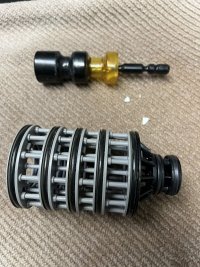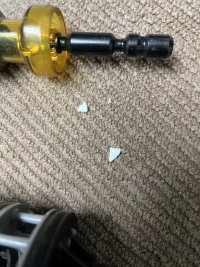WMG
New Member
Hi,
I have the following system:
Uranium Reduction Lower Chamber .5 CF/Softener Upper Chamber 1.25 CF Meter VortechMid 1054Black/Counter Current Upflow CK10EE-1.5 GPM DLFC
18x40 Brine Tank
Periodically I have been noticing very salty water after a regeneration, and sometimes a full brine tank (up to the safety float). I have checked both the brine draw venturi and the drain line flow control. Venturi has been fine, and I can see the brine draw during regeneration. Occasionally, I have found some mineral deposits in DLFC. The drain line is probably 20' in length and goes up from the water softener 4-5' to exist the house.
To resolve the issues, I recently took apart the valve body and cleaned the seal pack to remove the build up of mineral deposits (pictures attached). However, even after the recent cleaning I am still getting salty water and a very full brine tank. In the most recent regeneration, I noticed that the brine tank was full prior to the backwash, rinse, and fill stages of the regeneration (which occur at the end of the cycle). However, I am quite certain that the brine tank was less full in the prior day (before regeneration) -- leading me to believe that the brine tank is being filled during one of the other regeneration stages.
Any advice on what I should check for next? My current plan is to open up the valve again and check the seal pack / valve body for more mineral build up.
Thanks in advance!
-Wes
I have the following system:
Uranium Reduction Lower Chamber .5 CF/Softener Upper Chamber 1.25 CF Meter VortechMid 1054Black/Counter Current Upflow CK10EE-1.5 GPM DLFC
18x40 Brine Tank
Periodically I have been noticing very salty water after a regeneration, and sometimes a full brine tank (up to the safety float). I have checked both the brine draw venturi and the drain line flow control. Venturi has been fine, and I can see the brine draw during regeneration. Occasionally, I have found some mineral deposits in DLFC. The drain line is probably 20' in length and goes up from the water softener 4-5' to exist the house.
To resolve the issues, I recently took apart the valve body and cleaned the seal pack to remove the build up of mineral deposits (pictures attached). However, even after the recent cleaning I am still getting salty water and a very full brine tank. In the most recent regeneration, I noticed that the brine tank was full prior to the backwash, rinse, and fill stages of the regeneration (which occur at the end of the cycle). However, I am quite certain that the brine tank was less full in the prior day (before regeneration) -- leading me to believe that the brine tank is being filled during one of the other regeneration stages.
Any advice on what I should check for next? My current plan is to open up the valve again and check the seal pack / valve body for more mineral build up.
Thanks in advance!
-Wes






